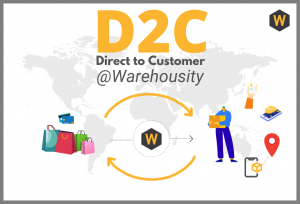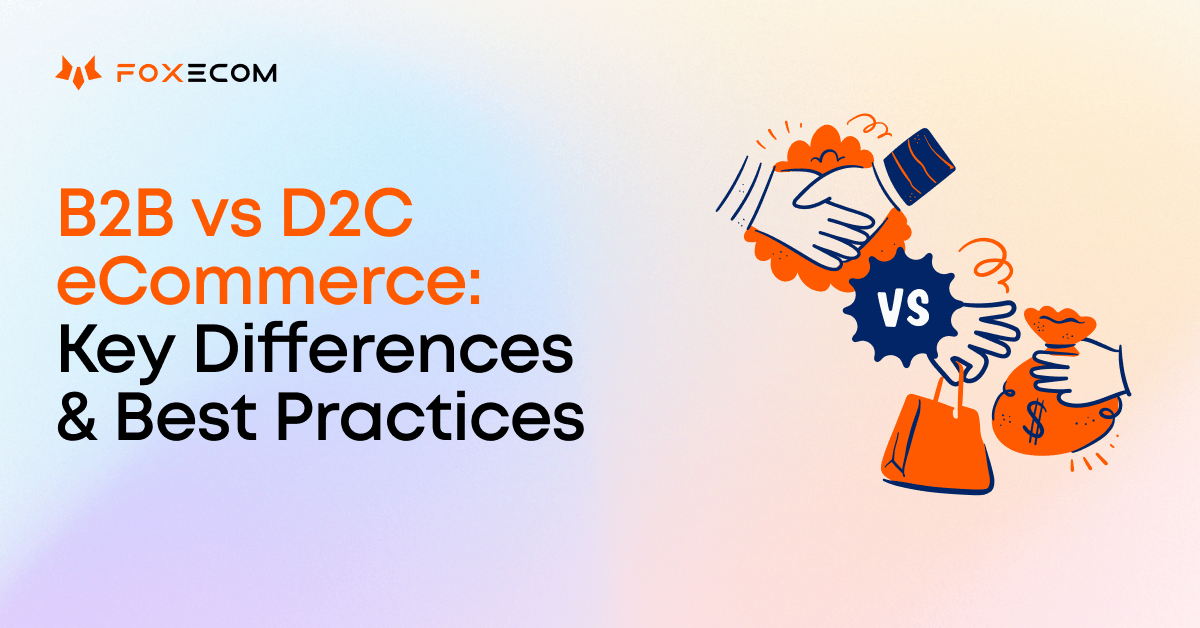Discovering the Prospective of D2C Ecommerce: A Comprehensive Overview for Services
The D2C ecommerce version presents a substantial shift in exactly how brand names engage with customers. It makes it possible for business to bypass conventional retail channels, promoting deeper links and potentially increased earnings margins. However, this method is not without its intricacies. Recognizing the subtleties of D2C ecommerce is crucial for brand names intending to prosper. What approaches can they embrace to navigate this evolving landscape effectively? The solutions may redefine their organization methods.
Comprehending the D2C Ecommerce Version

Trick Perks of D2C Ecommerce for Brands
The D2C ecommerce version supplies brands considerable benefits, especially concerning boosted earnings margins. By getting rid of intermediaries, companies can retain a bigger share of sales profits. Additionally, this direct relationship with clients cultivates enhanced brand loyalty, motivating repeat purchases and lasting involvement.
Raised Profit Margins

Enhanced Brand Commitment
Structure on the economic advantages of D2C ecommerce, improved brand commitment becomes another necessary advantage for companies involving directly with customers. By developing a direct link, brands can promote much deeper partnerships with their customers, getting understandings into actions and preferences. This direct interaction permits for more tailored advertising methods, which resonate highly with consumers. Additionally, brand names have the chance to control their messaging and customer experience, reinforcing brand worths and constructing depend on. When customers feel an individual connection, they are much more likely to return, support for the brand, and join neighborhood interaction. Eventually, boosted brand commitment not just drives repeat acquisitions however additionally grows an enthusiastic consumer base, more solidifying a brand name's setting out there.
Difficulties Encountered by D2C Brands
D2C brands experience several substantial obstacles that can affect their success. Supply administration issues can result in equip shortages or excess, complicating procedures and client satisfaction. Furthermore, advertising budget plan constraints commonly limit the capacity to efficiently involve and get to target audiences.
Supply Administration Issues
Reliable inventory monitoring provides an awesome challenge for several brand names running in the direct-to-consumer (D2C) room. These brands commonly face rising and fall demand, which can cause overstock or stockouts, inevitably impacting consumer fulfillment and profits. In addition, the lack of advanced stock radar can result in inconsistencies in between real stock degrees and reported information, complicating order satisfaction. The diverse variety of products D2C brand names normally supply additionally makes complex supply monitoring, as variations in colors, designs, and dimensions need more meticulous oversight. Lots of D2C services might battle with restricted warehousing capabilities, leading to ineffective usage of space and resources. Subsequently, reliable stock administration continues to be a critical obstacle for D2C brands intending for sustainable development and functional effectiveness.
Advertising Budget Constraints
Steering advertising and marketing budget plan restrictions is a considerable challenge for numerous direct-to-consumer (D2C) brands. Restricted financial sources commonly limit these companies' capacity to invest in comprehensive advertising approaches, leading to decreased presence in an affordable market. D2C brand names often face the requirement to make the most of roi (ROI) while targeting certain target markets efficiently. here This difficulty is worsened by rising expenses in electronic advertising and marketing and the requirement to allocate funds throughout numerous channels, including social networks, internet search engine, and email advertising. Subsequently, many D2C brands need to introduce cost-efficient advertising options, leveraging organic growth approaches and influencer partnerships. Ultimately, effectively maneuvering these budget plan restrictions is important for sustaining development and achieving long-term success in the advancing ecommerce landscape.
Strategies for Building a Successful D2C Ecommerce Company
As consumers progressively look for straight links with brands, establishing a successful D2C ecommerce service needs a tactical strategy that prioritizes customer engagement and depend on. One reliable approach is to produce compelling brand narratives that reverberate with target market, promoting emotional links. Using social networks platforms can enhance exposure and promote two-way communication, permitting brands to engage directly with customers.Moreover, personalized experiences through customized marketing efforts can greatly improve customer retention and loyalty. Carrying out loyalty programs and providing unique bargains can further incentivize repeat purchases.Streamlining the acquiring procedure is essential, making certain a straightforward user interface that improves the shopping experience. Furthermore, transparent interaction pertaining to shipping and returns builds count on and encourages customer confidence.Finally, actively seeking customer comments and replying to it shows a dedication to renovation and consumer complete satisfaction, important components in the competitive D2C landscape.
Leveraging Technology for Improved Customer Experience
In today's affordable D2C ecommerce landscape, modern technology plays an essential role in forming client experiences. Businesses significantly utilize innovative devices such as artificial intelligence, chatbots, and individualized algorithms to boost communications and streamline the buying procedure. By integrating these modern technologies, brands can provide tailored product referrals based on private preferences and shopping habits, fostering a more engaging experience.Moreover, receptive website designs and mobile applications assure that consumers can access solutions effortlessly throughout various tools. Improved settlement solutions, including digital pocketbooks and one-click checkouts, additionally streamline transactions, making it simpler for customers to make purchases.Data analytics likewise makes it possible for companies to gather insights into consumer behavior, allowing for continuous improvement of offerings and solutions. In general, leveraging innovation not just enhances consumer complete satisfaction however likewise cultivates commitment, eventually driving long-lasting success in the D2C ecommerce market.
Marketing Tips to Drive D2C Sales
Just how can brand names successfully capture the focus of consumers in a saturated market? To flourish in the direct-to-consumer (D2C) landscape, brands need to utilize targeted advertising and marketing methods. Utilizing social media systems, brand names can engage customers via interactive content, influencer partnerships, and user-generated articles. Individualized email campaigns can also cultivate a feeling of connection, providing tailored promos based on customer actions and preferences.Moreover, narration plays a vital duty in differentiating a brand's narrative, making it memorable and relatable. Brands ought to purchase search engine optimization (SEARCH ENGINE OPTIMIZATION) to enhance visibility, ensuring their items are easily visible online. In addition, leveraging information analytics enables companies to improve their advertising and marketing strategies and recognize consumer trends much better. Inevitably, a multi-channel approach that incorporates creativity with data-driven insights can significantly improve D2C sales, permitting brand names to stick out in a crowded marketplace.
Future Trends in D2C Ecommerce
With the quick development of innovation and consumer preferences, the future of D2C ecommerce is poised for substantial improvement. Emerging patterns show a shift in the direction of hyper-personalization, where brand names leverage data analytics to customize offerings to private customer demands. This modification enhances customer experiences, cultivating commitment and engagement.Moreover, sustainability is ending up being a necessary variable, with consumers increasingly preferring brand names that focus on green practices - D2C Ecommerce Agency. Companies are expected to embrace clear supply chains and lasting materials to satisfy this demand.The assimilation of expert system and augmented truth will additionally revolutionize the purchasing experience, allowing customers to picture products in their atmospheres before acquisition. Additionally, social commerce is expected to grow, as systems like Instagram and TikTok facilitate seamless shopping experiences directly within social media.These trends jointly represent a vibrant future for D2C ecommerce, highlighting customer-centric strategies and cutting-edge modern technologies that redefine customer interactions
Regularly Asked Inquiries
What Industries Benefit The Majority Of From D2C Ecommerce?
The current question highlights sectors that flourish with direct-to-consumer (D2C) ecommerce. Remarkably, style, elegance, electronic devices, and food fields leverage D2C versions to raise brand loyalty, improve client partnerships, and maximize revenue margins properly.
Just How Do Delivering Expenses Influence D2C Pricing Methods?
Delivering prices substantially influence D2C pricing approaches. Organizations have to balance these expenses with affordable prices, considering customer assumptions and profit margins. Reliable management of delivery can enhance client satisfaction and drive sales in direct-to-consumer designs.
What Settlement Choices Should D2C Companies Offer?
D2C companies need to provide diverse settlement options, consisting of credit/debit cards, electronic wallets, and get currently, pay later on solutions. This range enhances client comfort, boosts conversion prices, and caters to different customer preferences in the on the internet shopping landscape.
How Can D2C Brands Deal With Customer Returns Successfully?
D2C brands can manage customer returns effectively by applying easy to use return plans, supplying prepaid delivery tags, and making certain timely refunds (D2C Ecommerce Agency). Clear interaction and streamlined procedures improve client complete satisfaction and motivate repeat business
What Legal Considerations Exist for D2C Ecommerce Workflow?
Lawful considerations for D2C ecommerce operations consist of compliance with consumer defense legislations, data privacy guidelines, intellectual residential property civil liberties, and tax requirements. Brand names have to navigate these intricacies to prevent legal risks and assure smooth procedures. By getting rid of intermediaries, D2C brands can provide competitive rates and cultivate a much more intimate relationship with their customers.The D2C model is identified by its dependence on digital systems, making it possible for brand names to make use of social media, online markets, and their own web sites to engage with consumers directly. D2C ecommerce assists in the collection of useful client data, enabling brands to customize their offerings and marketing strategies efficiently, eventually driving sales and raising margins. Additionally, brand names have the possibility to manage their messaging and client experience, enhancing brand worths and building trust fund. As consumers progressively look for direct connections with brands, establishing a successful D2C ecommerce company requires a tactical method that focuses on consumer involvement and trust. D2C brand names can handle consumer returns efficiently by applying user-friendly return plans, offering pre paid delivery labels, and making certain timely reimbursements.